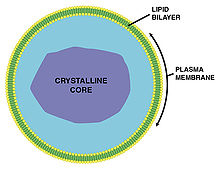Ribosomes are the granular structures first observed under the electron microscope as dense particles by George Palade (1953). They are composed of ribonucleic acid RNA) and proteins and are not surrounded by any membrane.
Except mammalian RBC all living cells have ribosomes. (Both prokaryotes & Eukaryotes) Ribosomes are smallest cell organelles.
Ribosomes are also called as "Organelle within organelle" and "Protein factory of cell"
Types of Ribosomes :
1) Eukaryotic ribosomes :- 80S- Occur in cytoplasm of eukaryotic cells.
2) Prokaryotic ribosomes :- 70 S- Occur in cytoplasm and associated with plasma membrane of prokaryotic cell. Their size is 15 to 20 nanometre.
70 S ribosome also present in mitochondria and chloroplast of eukaryotes.
S=Svedberg unit or Sedimentation rate. It indirectly is a measure of density and size.
Each ribosome composed of two subunits i.e, larger and smaller subunits
80 S - 60 S+ 40s 70 S - 50 S + 30 S
Magnesium ion is essential groups of for the binding the ribosome subunits. Mg form ionic bond with phosphate r- RNA of two subunits. Minimum 0.001 M Mg concentration is required for structural formation of ribosomes.
Chemical Composition of Ribosomes :
70 S 60% r- RNA + 40% proteins 80 S - 60 S - 40 S - 40% r-RNA + 60% proteins rRNA 28S, 5.8 S, 5 S rRNA 18S 50 S - rRNA 23S, 5S 30 S = RNA 16 S
At the time of protein synthesis, several 70 S ribosomes become attached to m-RNA with the help of smaller subunits. This structure is called polyribosome or polysome vs Ribosome Large subunit (50s) contains peptidyl transferase enzyme (23S rRNA) which helps in the formation of peptide bond during protein synthesis. This is an example of Ribozyme. (Noller 1992)
CYTOSKELETON

An elaborate network of filamentous proteinaceous structures present in the cytoplasm is collectively referred to as the cytoskeleton The cytoskeleton in a cell are Involved in many functions such as mechanical support motility maintenance of the shape of the cell.
MICROTUBULES

Microtubules are composed of protein, Tubulin (Size 25 nm).
In plants microtubules often found associated with cell wall. Probably these transport cell wall material from Golgi body to outside of cell. During cell division these microtubules form spindle fibers.
MICROFILAMENTS

They are composed of contractile protein Actin which concern with muscle contraction, Microtubules and microfilament are part of cytoskeleton-base of cell. [Size 6-7 nm)
INTERMEDIATE FILAMENT
Intermediate filaments has size/diameter in between microfilaments and microtubules. These filaments form basket like structure around the nucleus. [Size 8-12 nm]
CILIA AND FLAGELLA
Cilia (sing. cilia) and flagella (sing: flagellum) are hair-like outgrowths of the cell membrane. Cilia are smal structures which work like oars, causing the movement of either the cell or the surrounding fluid Flagella are comparatively longer and responsible for cell movement. The bacteria (prokaryotic cell also possess flagella but these are structurally different from that of the eukaryotic flagella

The electron microscopic study of a cilium or the flagellum show that they are covered with plasma membrane.
Their core called the axoneme, possesses a number of microtubules running parallel to the long axis. The axoneme usually has nine doublets of radially arranged peripheral microtubules, and a pair of centrally located microtubules. Such an arrangement of axonemal microtubules is referred to as the 9+2 array
(9 doublet + 2 singlet)
Arms of A tubules consist of an enzymatic protein dynein similar to myosin of muscle cells. Dynein have ability of hydrolysis of ATP & Liberates energy for ciliary and flagellar movement.
The central tubules are connected by bridges and is also enclosed by a central sheath, which is one of the tubules of each peripheral doubles by radial spoke. Thus there are nine radial
connected to spokes, The peripheral doublets are also interconnected by lakers. Both the cilium & flagella emerge from centriole like structure called the basal bodies or blepharoplasty.
CENTROSOME and CENTRIOLES
Centrosome is absent in higher plants.

Centrosome containing twa centrioles (diplosome) located just outside the nucleus and lie at right angle 1909 each other. Each centriole is surrounded by amorphous pericentriolar materials.
Centrioles are membraneless cylindrical structure which exhibicari wheel structure in transverse section Centriole mainly consist of 9 evenly spaced peripheral triplet fibrils of tubulin. These triplets are linke with the help of A-C linker.
The central part of the centriole is proteinaceous and called the hub, which Is connected with peripher triplets by radial spokes made of protein (9 + 0 arrangement) Centrioles are self duplicating units.
Function :
In animal cells, centrioles play important role in cell division by arranging spindle fibres between two poles of cell. The location of centrioles during cell division decides the plane of division. The plane of division is always at right angle to the spindle.
Centrioles form the basal body of cilia or flagella.
MICRO-BODIES
These are many, membrane bound minute vesicle contain various enzyme that are present in both plant and animal cells.

1) Peroxisomes and ribosomes :
These are found in both plant and animal cells. Peroxisomes contain catalase enzyme which is concerned with peroxide (HO Metabolism. Catalase degrade the H,O into water and oxygen
In plants, peroxisomes occurs in cells of green tissues and concerned with photorespiration (glycolate pathway).
Peroxisomes are also involved in B-oxidation of fatty acids,
(2) Glyoxysomes :
Glyoxysomes occurs only in plants especially in fatty seeds (castor seed, ground nut seed etc.).
Glyoxysomes are considered as a highly specialised peroxisomes Glyoxylate acid cycle takes place in glyoxysomes. This cycle convert fats into carbohydrates.









0 comments:
Post a Comment
If you have any doubts. Please let me know.